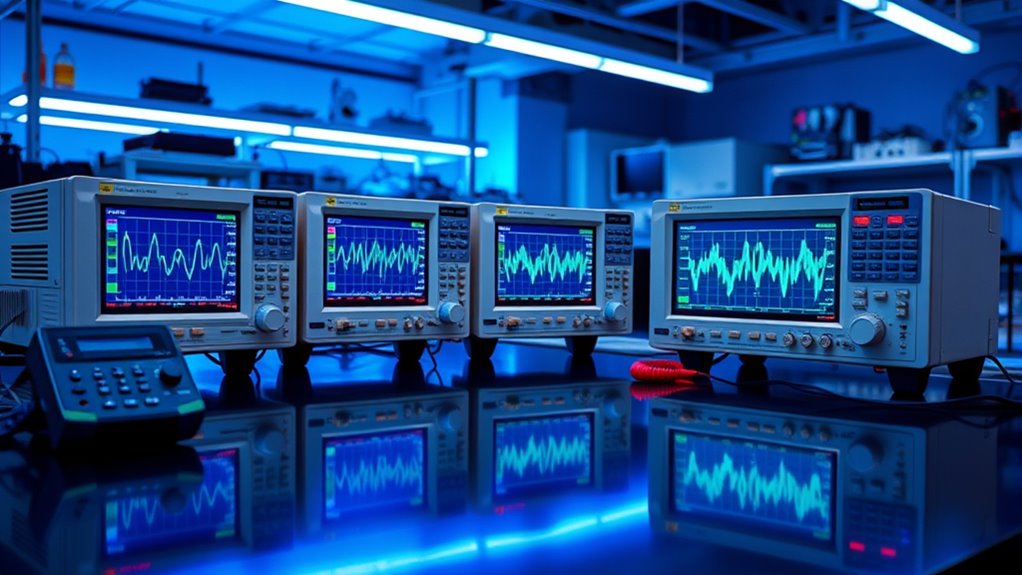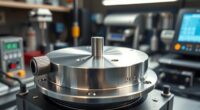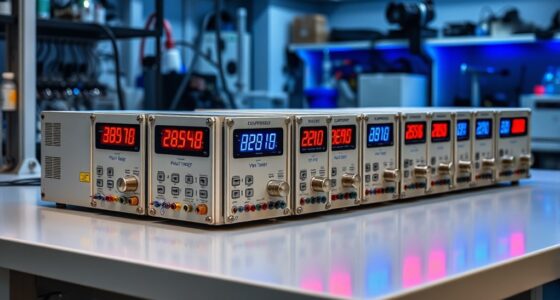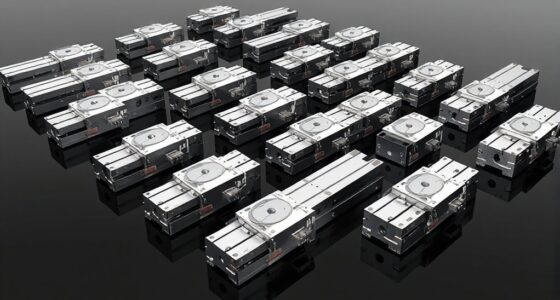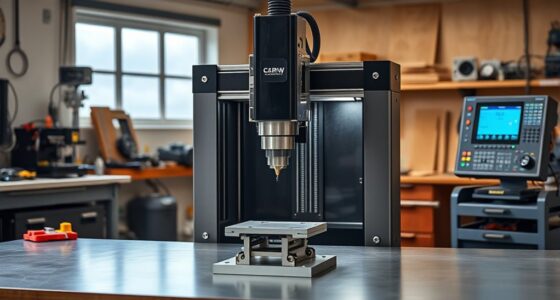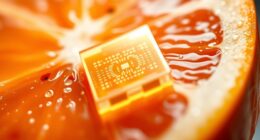If you’re looking for the 14 best digital storage oscilloscopes for precise signal analysis in 2025, I recommend considering models like the portable HANMATEK, high-performance Rigol DS1104Z-S Plus, and versatile Hantek DSO2 series. These devices offer advanced features such as high sampling rates, deep memory, and integrated analysis tools, making them ideal for various applications. Keep exploring, and you’ll find detailed insights to help you choose the perfect oscilloscope for your needs.
Key Takeaways
- High bandwidth models up to 250 MHz ensure accurate analysis of diverse signal frequencies in 2025.
- Deep memory options (up to 24 Mpts) facilitate precise waveform storage and complex data analysis.
- Advanced features like protocol decoding, FFT, and Lissajous figures enhance diagnostic accuracy.
- High sampling rates (up to 3 GSa/s) allow detailed real-time waveform capture.
- User-friendly interfaces with large displays and versatile connectivity options improve measurement efficiency.
HANMATEK Handheld Digital Oscilloscope 50MHz Bandwidth
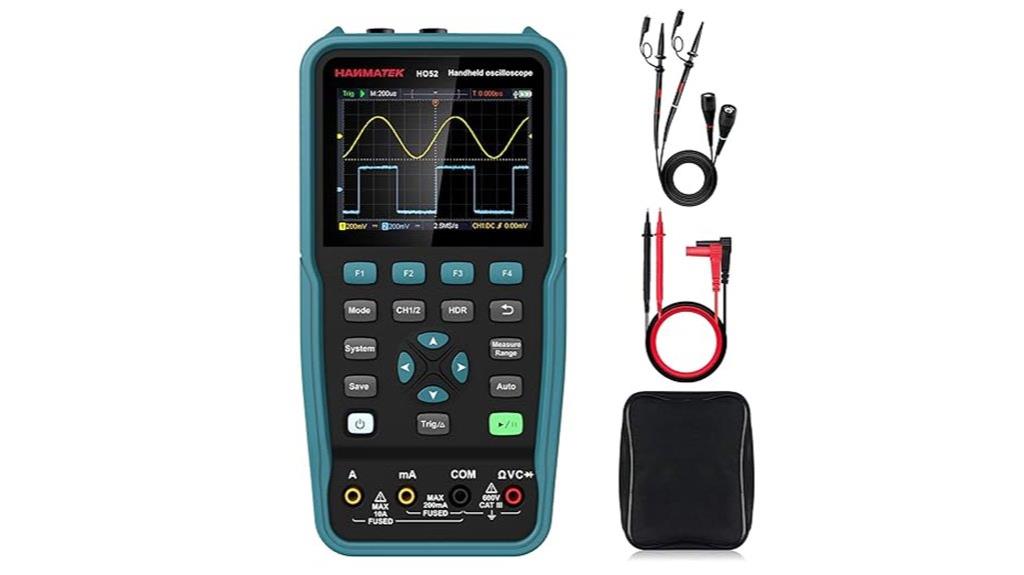
If you need a portable oscilloscope that balances ease of use with solid performance, the HANMATEK Handheld Digital Oscilloscope 50MHz is an excellent choice. It features a 50MHz bandwidth with 2 channels, a real-time sampling rate of 250MSa/s, and an 8k-dot recording capacity. The device’s 3.5-inch TFT screen displays waveforms clearly, and automatic measurements streamline testing. Its lightweight design (around 2.6 pounds) and support for USB Type-C power make it ideal for fieldwork. Though basic in trigger options and manual controls, it offers reliable signal analysis for troubleshooting, educational purposes, and hobbyist projects, all within a compact, user-friendly package.
Best For: hobbyists, students, and field technicians seeking a portable, easy-to-use oscilloscope for basic signal analysis and troubleshooting.
Pros:
- Compact, lightweight design weighing around 2.6 pounds for easy portability
- 50MHz bandwidth with 250MSa/s sampling rate suitable for various testing applications
- Features automatic measurements and waveform saving functions for efficient analysis
Cons:
- Basic trigger options and limited manual controls may hinder advanced testing needs
- No channel math or sophisticated trigger features found in higher-end models
- Protective case and rear stand may be less durable or somewhat inconvenient
Rigol DS1104Z-S Plus Digital Oscilloscope
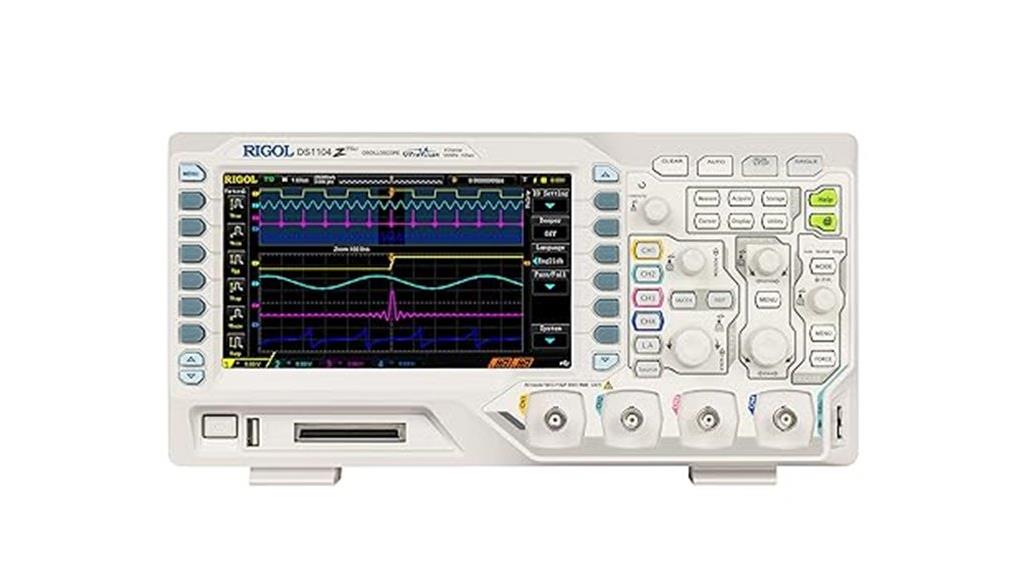
The Rigol DS1104Z-S Plus stands out for users seeking a versatile digital oscilloscope with deep memory and multiple analysis features. It offers a 100 MHz bandwidth, four channels, and a 1 GSa/s sampling rate, perfect for detailed waveform capture. Its 24 Mpts ultra-deep memory and high waveform capture rate ensure precise analysis. The scope includes a built-in 25 MHz two-channel signal source and a digital logic connector for MSO upgrades. Despite some interface quirks, such as a multifunction knob without click stops and manual display adjustments, it provides excellent value for microcontroller testing, repairs, and electronics development, making it a reliable, feature-rich choice.
Best For: electronics engineers, microcontroller developers, and technicians seeking a feature-rich, versatile oscilloscope for detailed waveform analysis and protocol decoding.
Pros:
- Deep 24 Mpts memory and high waveform capture rate enable precise and detailed signal analysis.
- Multiple built-in features, including signal source, generator, and decoding capabilities, enhance versatility.
- Compatible with logic analyzers and supports firmware updates for customization and expansion.
Cons:
- Multifunction knob lacks click stops, making precise adjustments difficult without hardware modification.
- Manual display adjustments are often required, and auto settings can produce cluttered or unreadable views.
- Slow screen redraws and menus occupying screen space can hinder efficient operation and usability.
Hantek DSO2C10 Digital Storage Oscilloscope
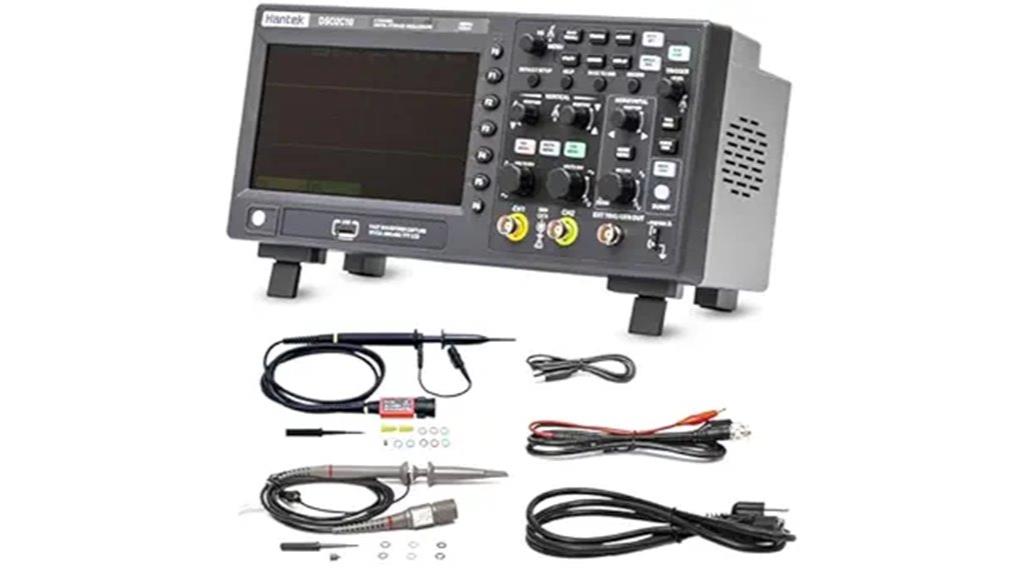
For hobbyists, students, and small labs seeking a budget-friendly yet versatile oscilloscope, the Hantek DSO2C10 stands out with its impressive 100MHz bandwidth and dual-channel design. It features a 1GSa/s sampling rate, 8M memory depth, and support for arbitrary waveform output, along with 14 trigger modes—including serial protocol decoding. Its color display, waveform storage, and measurement cursors make diagnostics straightforward. The device doubles as a signal generator up to 25MHz, offering excellent value for basic electronics work. While it has some limitations like slower display updates and a plastic chassis, firmware support and community tips enhance its usability for educational and hobbyist projects.
Best For: hobbyists, students, and small laboratories seeking an affordable, versatile oscilloscope for basic electronics diagnostics and educational projects.
Pros:
- Cost-effective with impressive 100MHz bandwidth and dual channels
- Supports arbitrary waveform output and serial protocol decoding for versatile testing
- User-friendly interface with waveform storage and measurement cursors
Cons:
- Slower CPU results in less responsive display updates
- Plastic chassis feels cheap and slightly loose knobs
- Limited external probe options and potential firmware responsiveness issues
Hantek DSO2D15 Digital Storage Oscilloscope
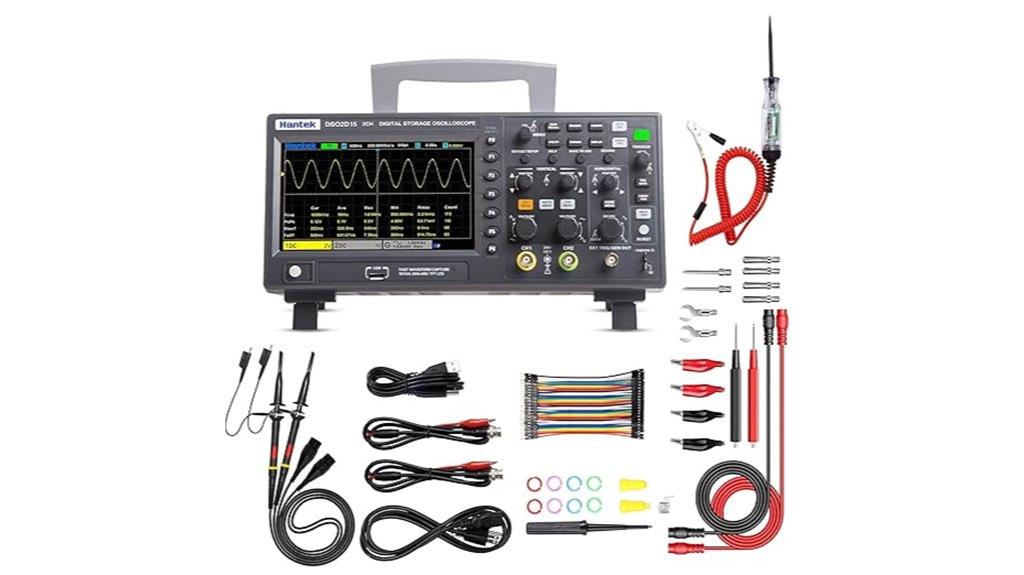
The Hantek DSO2D15 stands out as an excellent choice for beginners and hobbyists seeking versatile signal analysis without breaking the bank. It features 150MHz bandwidth, 8M deep memory, and a 1 GSa/s sampling rate, delivering clear, detailed waveforms. Its built-in 25MHz waveform generator supports arbitrary waveforms, ideal for audio projects. The 7-inch color TFT display provides excellent visualization, while two independent channels with dedicated controls simplify testing. With over 1000 stored waveforms, USB connectivity, and protocol analysis capabilities, it covers many needs. Although some controls respond slowly, its affordability and feature set make it a reliable entry-level scope for educational and hobbyist use.
Best For: entry-level hobbyists, students, and educators seeking an affordable, versatile oscilloscope for basic signal analysis and audio projects.
Pros:
- Affordable price with a comprehensive feature set suitable for beginners
- Built-in waveform generator supporting arbitrary waveforms and modulation
- Large, clear 7-inch color display with easy-to-use interface
Cons:
- Slow response of buttons and knobs requiring multiple presses
- Limited internal termination options, needing external feedthrough for impedance measurements
- Some users experience electromagnetic interference and occasional firmware stability issues
FNIRSI 1013D Oscilloscope – Handheld Portable Digital Storage Kit
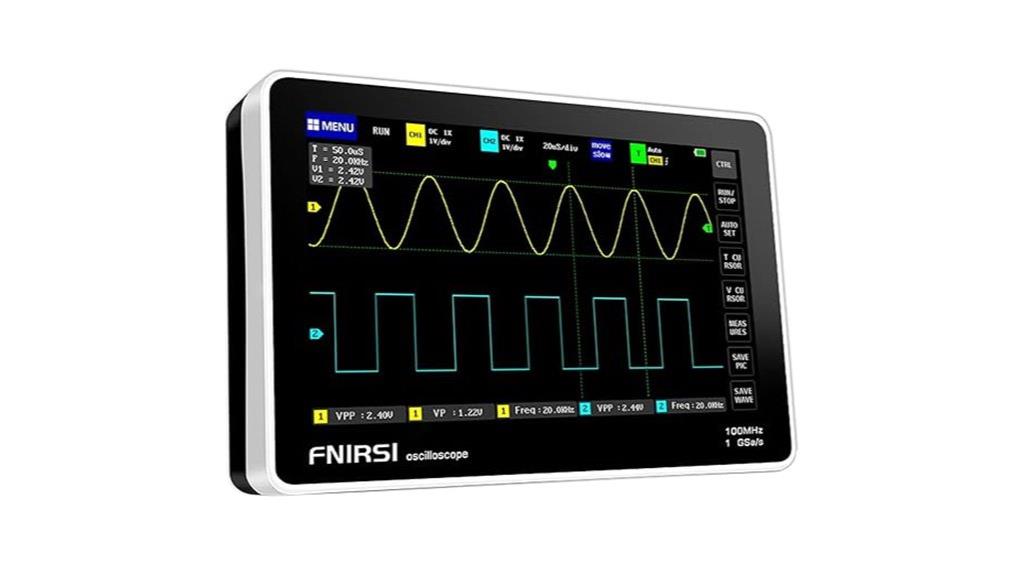
If you need a portable oscilloscope that combines ease of use with powerful features, the FNIRSI 1013D stands out. This handheld device boasts a 7-inch TFT LCD touch screen with 800×480 resolution, making data viewing straightforward. It offers 2 channels, 100 MHz bandwidth, and 1 GSa/s sampling rate, ideal for analyzing diverse signals. Its lightweight design, combined with a built-in 6000 mAh battery, ensures about four hours of mobile operation. With 1 GB of storage, it can save up to 1000 waveforms and screenshots. Its advanced features, like FFT analysis and Lissajous displays, enable precise signal insights on the go.
Best For: professionals and hobbyists who need a portable, easy-to-use oscilloscope with advanced analysis features for on-the-go signal testing and troubleshooting.
Pros:
- Compact, lightweight design with a built-in rechargeable battery for mobility
- High-resolution 7-inch touchscreen display for clear data visualization
- Supports advanced analysis tools like FFT and Lissajous graphs for in-depth signal inspection
Cons:
- Limited to 2 channels, which may restrict complex multi-signal analysis
- Battery life of approximately 4 hours might be insufficient for extended fieldwork
- Storage capacity of 1 GB could be limiting for large data sets or prolonged testing
RIGOL Digital Oscilloscope DHO804

Designed with engineers and hobbyists in mind, the Rigol DHO804 stands out thanks to its impressive 70MHz bandwidth combined with a high-resolution 12-bit ADC. Its real-time sampling rate reaches up to 1.25 GSa/s, ensuring precise waveform capture, while the 7-inch HD touchscreen and Flex knob make navigation intuitive. With four channels and up to 25 Mpts storage depth, it handles complex signals effortlessly. Built-in USB, LAN, and HDMI ports support seamless connectivity, and remote control via Wi-Fi adds flexibility. The scope’s ultra-low noise and fast FFT processing deliver reliable, accurate measurements, making it a versatile choice for precise signal analysis.
Best For: engineers, students, and hobbyists seeking a high-resolution, versatile oscilloscope with advanced connectivity features for precise waveform analysis.
Pros:
- High 12-bit resolution and up to 1.25 GSa/s sampling rate for accurate signal capture
- User-friendly 7-inch HD touchscreen combined with Flex knob for intuitive operation
- Multiple connectivity options including USB, LAN, HDMI, and Wi-Fi for remote control and data transfer
Cons:
- Limited bandwidth at 70MHz, which may restrict high-frequency signal analysis without upgrades
- Small pop-up window close buttons and probe color mismatches can affect usability slightly
- Absence of a built-in search feature in the manual, requiring external devices for detailed documentation searches
Oscilloscope
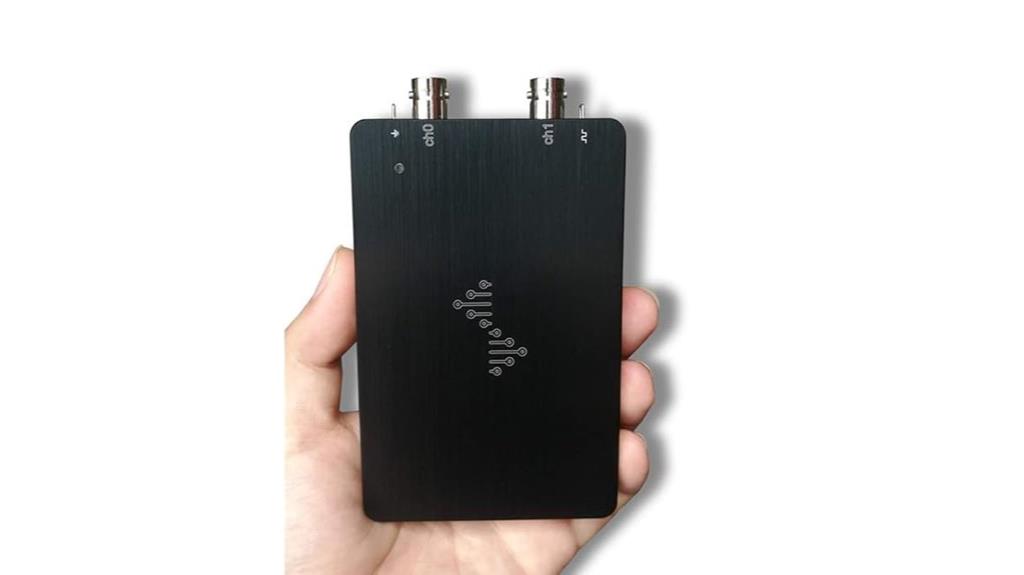
For engineers and technicians demanding precise signal analysis on the go, a portable oscilloscope with high bandwidth and sampling rate is essential. This compact device features two analog channels with up to 100 MHz bandwidth and a 1 GSa/s sample rate, thanks to a single-chip 1 GHz ADC. Its ultra-portable size fits in a shirt pocket, and it comes with a storage box for protection. Powered via USB-C, it connects easily to computers running Windows, macOS, or Linux using DSView software, which offers spectrum analysis and waveform visualization. Its FPGA engine and large onboard memory enable detailed, real-time waveform capture, making it ideal for field diagnostics and precise measurements.
Best For: engineers and technicians who need precise, portable signal analysis in the field with high bandwidth and sampling rate.
Pros:
- Compact and ultra-portable design fits in a shirt pocket for easy portability.
- High-performance specifications with up to 100MHz bandwidth and 1GSa/s sampling rate.
- Compatible with multiple operating systems and features advanced analysis tools via open-source DSView software.
Cons:
- Limited to two analog channels, which may not suit complex multi-signal testing.
- Requires USB power, which may limit use in environments without reliable USB connections.
- Advanced features like spectrum analysis and large memory may demand a steep learning curve for new users.
Hantek DSO5102P Digital Storage Oscilloscope
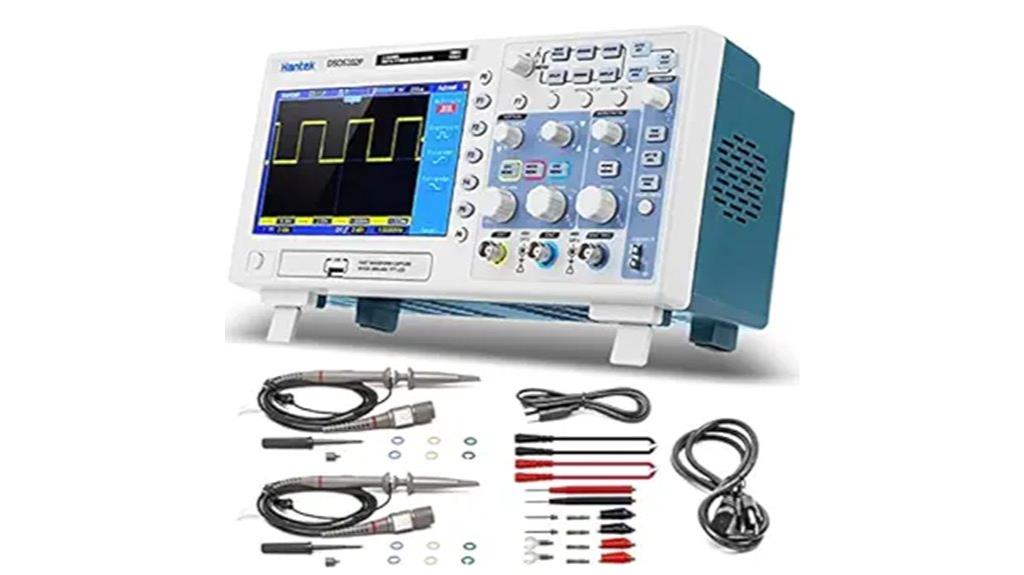
The Hantek DSO5102P stands out as an excellent choice for hobbyists and entry-level professionals seeking reliable signal analysis without breaking the bank. Its 100MHz bandwidth and 1GSa/s sampling rate deliver clear, detailed waveforms across sine, square, sawtooth, and triangular signals. The large 7-inch TFT LCD provides sharp visuals, while multiple trigger modes ensure versatile measurements. Connectivity options like USB ports facilitate waveform storage and PC analysis. Compact and user-friendly, it offers automatic measurements and intuitive controls, making it ideal for diagnosing circuits, automotive electronics, or educational projects. Despite minor build quirks, its value and performance make it a top budget-friendly oscilloscope for everyday use.
Best For: hobbyists, electronics enthusiasts, and entry-level professionals seeking an affordable yet reliable oscilloscope for general electronic testing and diagnostics.
Pros:
- Offers 100MHz bandwidth and 1GSa/s real-time sampling rate for clear waveform detail
- Large 7-inch color TFT LCD with easy-to-navigate interface and multiple trigger modes
- Supports waveform storage, PC connectivity, and multiple measurement functions at an affordable price
Cons:
- Limited internal cooling and occasional slow screen updates in certain modes
- Build quality issues like the feel of the power button and knob responsiveness noted by some users
- USB data transfer can be slow (~1 fps), and documentation may lack in-depth guidance
SainSmart Micsig Oscilloscope MDO2504

With its impressive 250MHz bandwidth and 3GSa/s sampling rate, the SainSmart Micsig Oscilloscope MDO2504 stands out as an excellent choice for engineers who need precise signal analysis. It features four analog channels and a 360Mpts memory depth, assuring accurate measurements of complex signals. Its ultra-thin design, measuring just 3.58cm, allows easy mounting and saves desktop space. The 14-inch touchscreen with 1920 x 1200 resolution provides clear waveform visualization. Equipped with SigTestUI, it offers an intuitive interface that’s easy to learn. Its low noise floor of less than 90μVrms at 500MHz guarantees reliable detection of even weak signals during debugging.
Best For: engineers and technicians seeking a high-performance oscilloscope with precise signal analysis, user-friendly interface, and versatile connectivity for complex electronic debugging.
Pros:
- 250MHz bandwidth and 3GSa/s sampling rate enable detailed and accurate signal measurement
- Ultra-thin 3.58cm design with a 14-inch high-resolution touchscreen for easy operation and space-saving setup
- SigTestUI provides an intuitive, easy-to-learn interface suitable for new engineers
Cons:
- The advanced features and large display may come at a higher price point, potentially limiting budget-conscious users
- Limited to four analog channels, which may be insufficient for very complex multi-signal testing needs
- Heavy reliance on specific proprietary interfaces (e.g., Mic-OPI probe) might limit compatibility with some external accessories
FNIRSI 1014D Oscilloscope with Signal Generator and High Voltage Probe
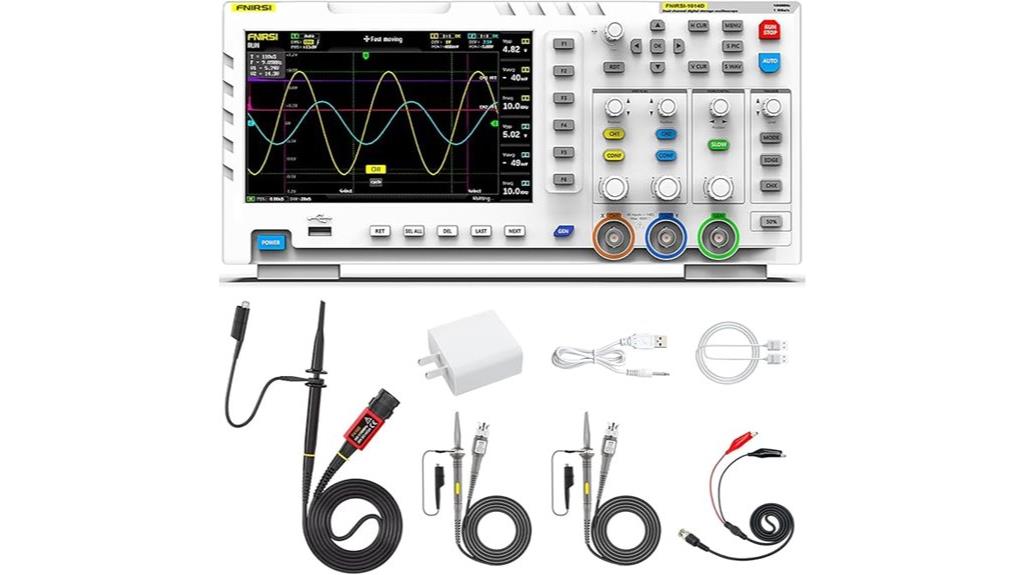
Designed for versatile signal analysis, the FNIRSI 1014D stands out thanks to its integrated signal generator and high-voltage probe, making it an ideal choice for engineers and technicians tackling complex measurements. It offers a real-time sampling rate of up to 1 GSa/s, with two channels and 100 MHz bandwidth per channel. The built-in DDS signal generator provides adjustable frequency and customizable signals, supporting up to 1000 user-defined waveforms. Its 7-inch LCD screen displays clear waveforms, while features like cursor measurements, FFT analysis, and Lissajous figures facilitate detailed signal inspection. The high-voltage probe supports measurements up to 100X, expanding testing options across various applications.
Best For: engineers and technicians performing complex analog and digital signal analysis requiring integrated testing tools and high-resolution visualization.
Pros:
- Combines oscilloscope, signal generator, and high-voltage probe in one device for versatile testing.
- Supports high sampling rate of 1 GSa/s and 100 MHz bandwidth for precise waveform capture.
- Features advanced analysis tools like FFT and Lissajous figures for detailed signal inspection.
Cons:
- Limited bandwidth of 100 MHz may not suit high-frequency applications.
- Built-in storage of 1GB might be insufficient for extensive data logging.
- LCD display size of 7 inches, while clear, could be small for detailed multi-waveform analysis.
FNIRSI 1014D Oscilloscope (DDS Signal Generator, 2 Channels)
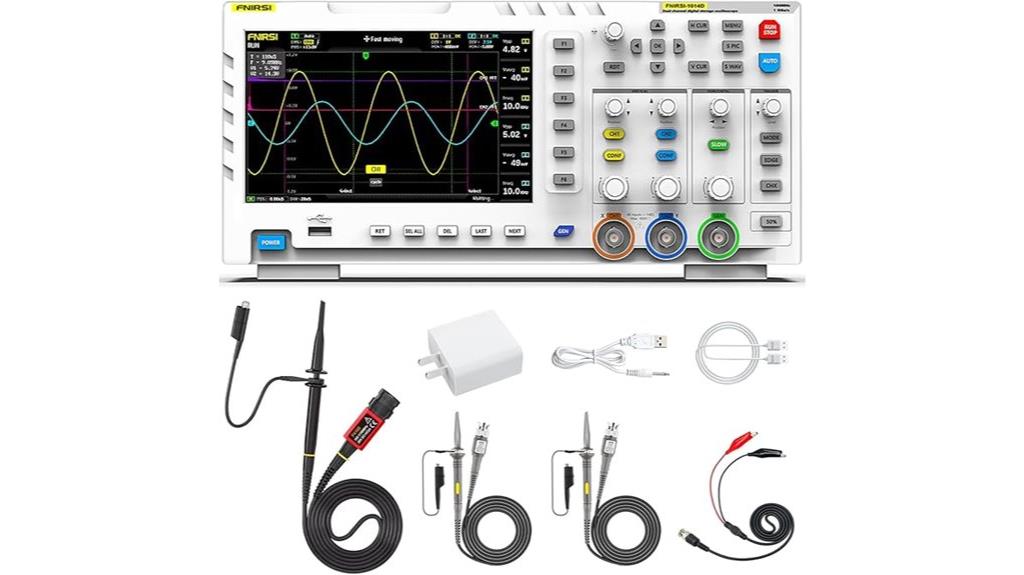
If you’re seeking a versatile oscilloscope capable of both precise signal analysis and integrated signal generation, the FNIRSI 1014D stands out. It offers a real-time sampling rate of up to 1 GSa/s with two channels and 100 MHz bandwidth, making it suitable for detailed analog and digital signals. Its built-in DDS signal generator provides chopping output with fine frequency steps and supports multiple predefined and custom signals, stored for easy access. The device’s intuitive features—cursor measurements, AUTO waveform display, and adaptive trigger sensitivity—streamline testing. Its 7-inch LCD, Lissajous display, FFT analysis, and 1GB storage make it a comprehensive tool for versatile signal analysis and generation.
Best For: electronics hobbyists and engineers seeking an all-in-one device for precise signal analysis and customizable signal generation with versatile testing features.
Pros:
- High real-time sampling rate of 1 GSa/s for detailed waveform capture
- Built-in DDS signal generator with customizable and predefined signals for flexible testing
- User-friendly features like cursor measurements, AUTO waveform display, and Lissajous graphics
Cons:
- Limited analog bandwidth of 100 MHz may not suit very high-frequency applications
- 1GB storage could be insufficient for extensive data logging without external support
- Smaller 7-inch LCD screen may be less comfortable for detailed long-term analysis
Hantek DSO2C10 Handheld Digital Storage Oscilloscope
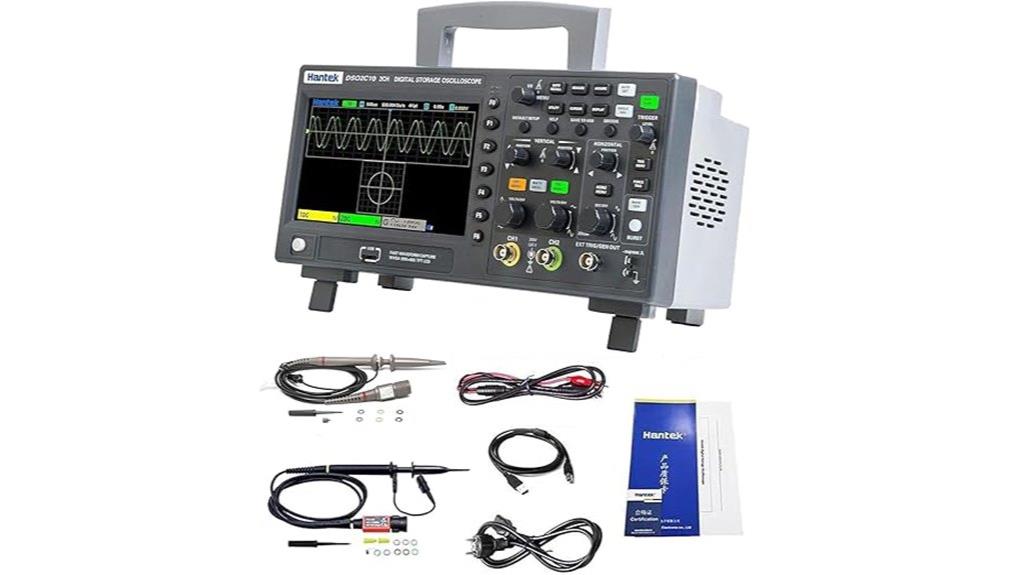
Looking for a portable oscilloscope that combines powerful features with ease of use? The Hantek DSO2C10 is an excellent choice. It offers 2 channels, a 100 MHz bandwidth, and a 1 GS/s sampling rate, making it versatile for detailed signal analysis. Its 8 M memory depth supports complex testing, and the included high-voltage probe expands its applications. The 7-inch TFT LCD with vibrant colors provides clear visuals, while built-in functions like a waveform generator and multiple data storage options streamline workflows. Suitable for fields like communication, aerospace, and research, the DSO2C10 is a reliable, portable solution for professionals on the go.
Best For: professionals and hobbyists seeking a portable, versatile oscilloscope for detailed signal analysis across communication, aerospace, research, and educational applications.
Pros:
- Compact, lightweight design for easy portability
- High-resolution 7-inch color display for clear visualization
- Built-in waveform generator and extensive data storage options
Cons:
- Limited to 2 channels, which may not suffice for complex multi-signal analysis
- 100 MHz bandwidth might be restrictive for ultra-high-frequency applications
- Battery life and operational duration are not specified, possibly limiting prolonged use
Siglent Technologies SDS1052DL+ 50 MHz Digital Storage Oscilloscope

The Siglent Technologies SDS1052DL+ stands out as an excellent choice for hobbyists and students seeking a reliable, budget-friendly digital storage oscilloscope with core measurement capabilities. It features a 50 MHz bandwidth, high-resolution LCD, and interfaces like USB and LAN, making it versatile and portable. The scope offers advanced triggers, cursors for precise measurements, FFT math functions, and a built-in frequency counter, all accessible through an intuitive on-screen menu. With 500 million samples per second, it displays signals up to 100 MHz effectively. Its user-friendly design, all-encompassing features, and affordability make it ideal for basic testing, amateur radio, and educational use.
Best For: hobbyists, students, and amateur radio enthusiasts seeking a budget-friendly, portable digital oscilloscope for basic measurements and educational purposes.
Pros:
- User-friendly interface with intuitive on-screen menus and helpful built-in help system
- Compact, lightweight, and portable design suitable for field use and easy setup
- High-resolution LCD display with advanced trigger options and FFT math functions for versatile testing
Cons:
- Waveform stability issues and limited trigger sensitivity at larger time divisions
- Less sophisticated FFT capabilities compared to higher-end models
- Single sweep speed setting and less convenient zoom adjustments may hinder detailed analysis
FNIRSI 2C53T Handheld Oscilloscope
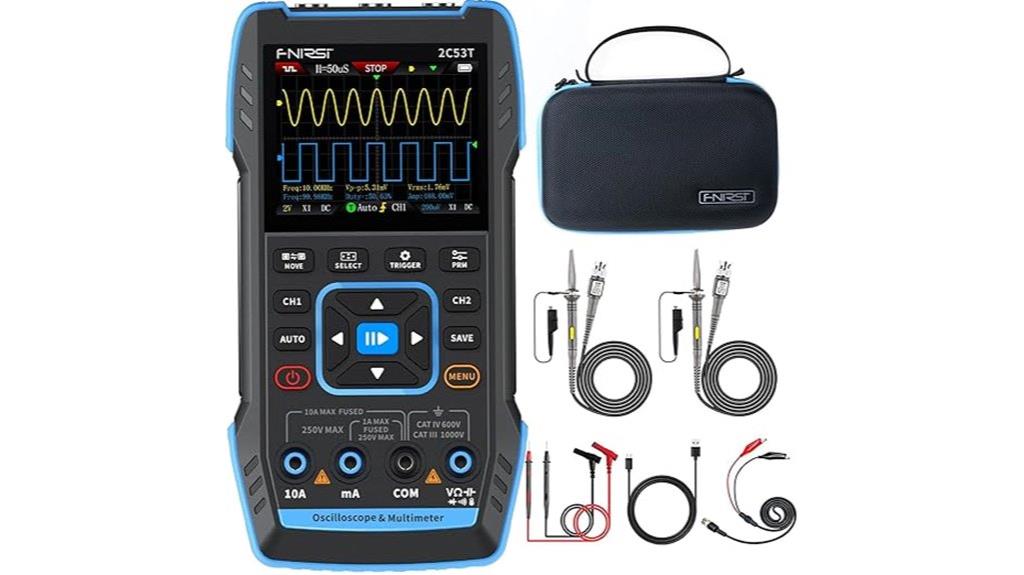
The FNIRSI 2C53T Handheld Oscilloscope stands out for its impressive combination of portability and versatile measurement features, making it an excellent choice for professionals, students, and hobbyists alike. Its upgraded design offers a broader measuring range, math operations, cursor measurements, persistence mode, and XY mode. With a 50 MHz bandwidth and 250 MSa/s sampling rate, it captures signals accurately. The device supports waveform storage, export, comparison, and automatic measurements. Its built-in high-voltage protection, 2.8-inch LCD, and long-lasting 3000 mAh battery make it practical for fieldwork. Overall, it’s a compact, feature-rich tool for precise signal analysis on the go.
Best For: professionals, students, and hobbyists seeking a portable, feature-rich oscilloscope for precise signal measurement and analysis in various environments.
Pros:
- Upgraded measuring range with advanced math, cursor, persistence, and XY modes for comprehensive analysis.
- Compact, portable design with built-in high-voltage protection and long-lasting battery for field use.
- Supports waveform storage, export, comparison, and automatic measurement, enhancing usability and data management.
Cons:
- Limited bandwidth of 50 MHz may not suit high-frequency signal analysis.
- Display size of 2.8 inches might be small for detailed viewing during complex tasks.
- Built-in signal generator frequency of 50 kHz may not meet requirements for higher-frequency applications.
Factors to Consider When Choosing Digital Storage Oscilloscopes
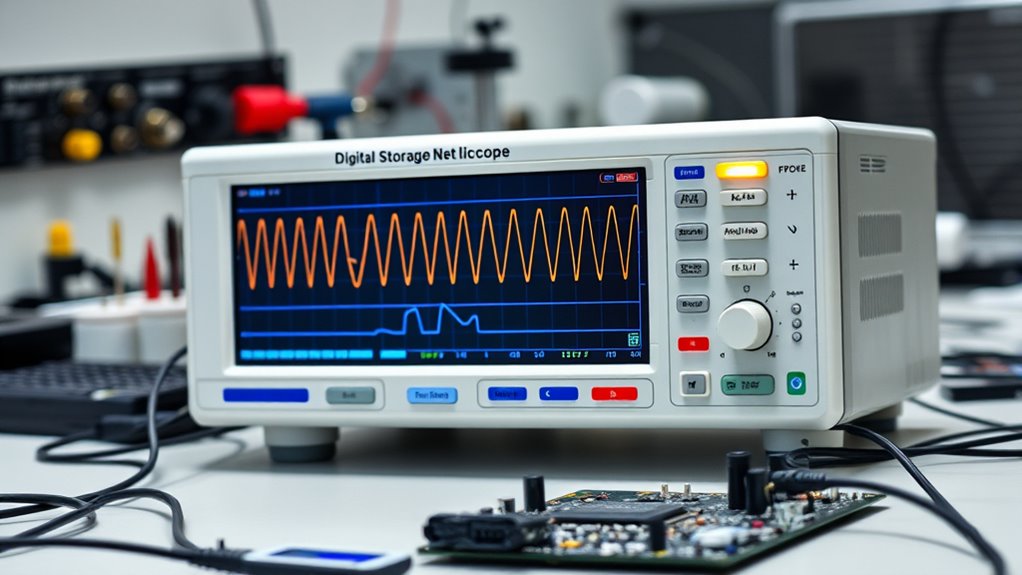
When selecting a digital storage oscilloscope, I focus on key factors that impact performance and usability. Things like bandwidth, sampling rate, and the number of channels determine how accurately I can analyze signals, while storage capacity and user interface influence ease of use. Connectivity options also matter, ensuring I can integrate the scope seamlessly into my workflow.
Bandwidth and Sampling Rate
Choosing the right digital storage oscilloscope involves understanding how bandwidth and sampling rate work together to guarantee accurate signal measurement. Higher bandwidth lets me measure signals with higher frequencies accurately, usually at least five times the highest frequency of interest. The sampling rate dictates how often data points are captured, affecting the ability to reconstruct fast-changing signals precisely. To avoid aliasing and get detailed views, I prefer a sampling rate at least twice the maximum signal frequency, though higher rates improve resolution. These two factors are interconnected—boosting bandwidth often means increasing the sampling rate to maintain measurement fidelity. For high-frequency signals or rapid transients, selecting an oscilloscope with both high bandwidth (over 100 MHz) and a sampling rate of several GSa/s ensures I capture waveforms accurately and analyze signals with confidence.
Number of Channels
Selecting the right number of channels is essential because it determines how many signals I can monitor simultaneously. With options typically ranging from 2 to 4 channels, I can perform more complex analyses, like observing phase differences or interactions between signals. Multi-channel oscilloscopes are valuable when dealing with multiple sources, but they also add complexity, requiring advanced triggering and synchronization features for accurate measurements. More channels often mean higher costs, increased size, and reduced portability, so I need to balance functionality with practicality. If I only need to test a single signal, a 2-channel scope might suffice. However, for exhaustive, multi-signal analysis, a 3- or 4-channel oscilloscope provides the versatility necessary for detailed insights.
Storage and Memory Depth
The memory depth of a digital storage oscilloscope directly impacts how much waveform data I can capture and analyze in detail. With deeper memory, I can record longer segments at high sampling rates, enabling me to examine extended or complex signals thoroughly. This is especially important when analyzing fast, high-frequency events where losing data could mean missing critical details. The memory is usually measured in points, like 8k, 40k, or even 25 million points, which directly influences the resolution and duration of recordings. I need to balance memory depth with sampling rate because higher rates require more memory to preserve signal fidelity. Insufficient memory can cause data truncation, leading to incomplete analysis and potential oversight of important waveform features.
User Interface Ease
An intuitive user interface can substantially streamline the operation of a digital storage oscilloscope, making complex measurements more accessible even for beginners. Clear labels on controls help reduce the learning curve, allowing users to quickly locate functions. Touchscreen displays with responsive multi-touch gestures enable fast navigation and waveform adjustments, saving time during testing. Well-organized menus and minimal clutter on the display make it easier to find settings quickly, improving efficiency. Features like auto-setup and automatic measurements simplify operation, especially for those new to oscilloscopes, reducing manual configuration. Tactile feedback from physical buttons and knobs enhances precision and builds confidence during adjustments. Overall, a user-friendly interface ensures smoother operation, less frustration, and more accurate signal analysis.
Connectivity Options
When choosing a digital storage oscilloscope, to consider its connectivity options, as these determine how easily you can transfer data, control the device remotely, or expand its functionalities. USB ports are essential for quick data export, firmware updates, and connecting to external storage or computers for detailed analysis. LAN or Ethernet interfaces enable remote access, network sharing, and integration with laboratory or industrial systems. HDMI or display outputs allow connecting the oscilloscope to larger monitors or projectors, improving visualization. Wireless options like Wi-Fi or Bluetooth enhance portability and remote operation, especially useful in field testing or environments where cables are inconvenient. These connectivity features substantially impact the oscilloscope’s versatility, ease of use, and integration into your workflow, making them vital factors in your selection process.
Frequently Asked Questions
How Does Bandwidth Impact Oscilloscope Measurement Accuracy?
Bandwidth directly influences an oscilloscope’s measurement accuracy by determining the highest frequency it can precisely capture. If the bandwidth is too low for your signal, you’ll miss or distort high-frequency details, leading to inaccurate readings. I always choose an oscilloscope with at least five times the signal frequency to ensure precise analysis. Higher bandwidths provide better fidelity, especially when working with fast, complex signals.
What Are the Key Differences Between Portable and Benchtop Models?
Portable oscilloscopes are compact, lightweight, and ideal for fieldwork or quick setups, offering convenience but often with limited bandwidth and fewer advanced features. Benchtop models, on the other hand, are heavier, larger, and designed for detailed analysis in labs, providing higher bandwidth, better resolution, and more sophisticated options. I find benchtops better for precision work, while portables excel when mobility and speed are priorities.
How Do Sampling Rates Influence Signal Fidelity?
Think of sampling rates like a camera capturing a fast-moving scene; the higher the rate, the clearer the picture. When sampling rates are high, signals are captured more accurately, preserving details and reducing distortion. But if they’re too low, important nuances get lost, like a blurry photo. So, for precise analysis, selecting a scope with a high sampling rate guarantees you catch every subtlety in your signals.
What Maintenance Is Required for Long-Term Device Reliability?
To keep my digital storage oscilloscope reliable over time, I regularly clean the probes and connectors to prevent dust and corrosion. I also calibrate it periodically to guarantee measurement accuracy. Additionally, I avoid exposing it to extreme temperatures or moisture, and I store it in a safe, dry place when not in use. These steps help me maintain peak performance and extend the device’s lifespan.
Can Oscilloscopes Analyze Complex Digital Communication Protocols?
Absolutely, oscilloscopes can analyze complex digital communication protocols. I once used a high-end scope to troubleshoot a faulty UART transmission in a medical device. By decoding protocol layers and timing, I identified signal integrity issues quickly. Modern digital oscilloscopes come with protocol decoders for CAN, Ethernet, I2C, and more, making it easier for engineers like us to diagnose and optimize intricate digital signals efficiently.
Conclusion
In my quest for the perfect digital storage oscilloscope, I’ve found that choosing the right one depends on your needs—whether it’s portability or advanced features. Just like steering the labyrinth of Daedalus, selecting the ideal scope can be tricky, but with the options I’ve shared, you’re better equipped. Remember, even in 2025, a reliable scope is your trusty Minotaur in signal analysis. Happy testing!
